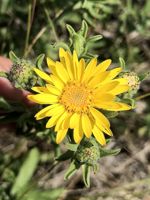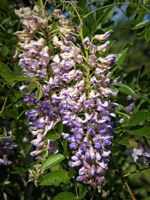Mon-Fri 9am - 5pm Mountain time
Blue Moon Wisteria vs Hairy Golden Aster
Heterotheca villosa
Wisteria macrostachya Blue Moon
NOT AVAILABLE THIS SEASON - MIGHT RETURN
Hairy Golden Aster is a native perennial wildflower known for its clusters of bright yellow, daisy-like blooms. They bloom from mid-summer into fall, providing late-season colour and a valuable nectar source for pollinators, including a variety of bee species.
Flowers mature into fluffy seed heads and can self-seed readily. Removing spent blooms helps manage their spread, but some people will choose to leave a few seed heads to provide food for birds. Hairy Golden Aster grow in bushy clumps, tolerates poor sandy soils, and once established, are among the most drought-tolerant wildflowers. They are well-suited for pollinator gardens, restoration, naturalization, and xeriscaping projects.
Blue Moon Wisteria is a striking, flowering vine, and the hardiest of the wisterias. Up to three times in one growing season you can expect showy, fragrant, lavender-blue flowers.
Make sure you plan your site as this vine requires a structure to support its mature weight. Try planting close to a post, trellis, or fence.
Hairy Golden Aster Quick Facts
Blue Moon Wisteria Quick Facts
Toxicity: can be toxic to cats, dogs, and horses when consumed

